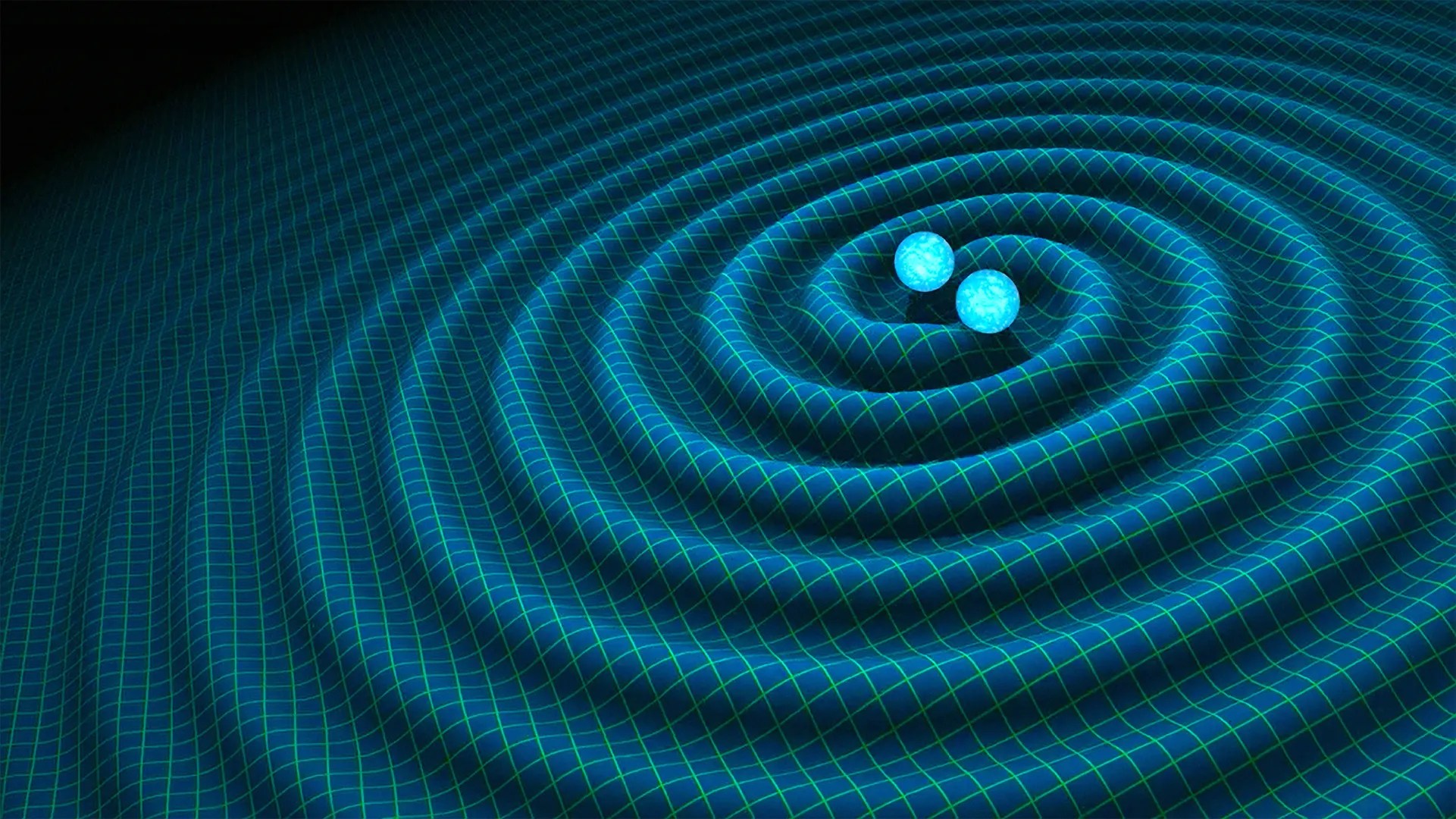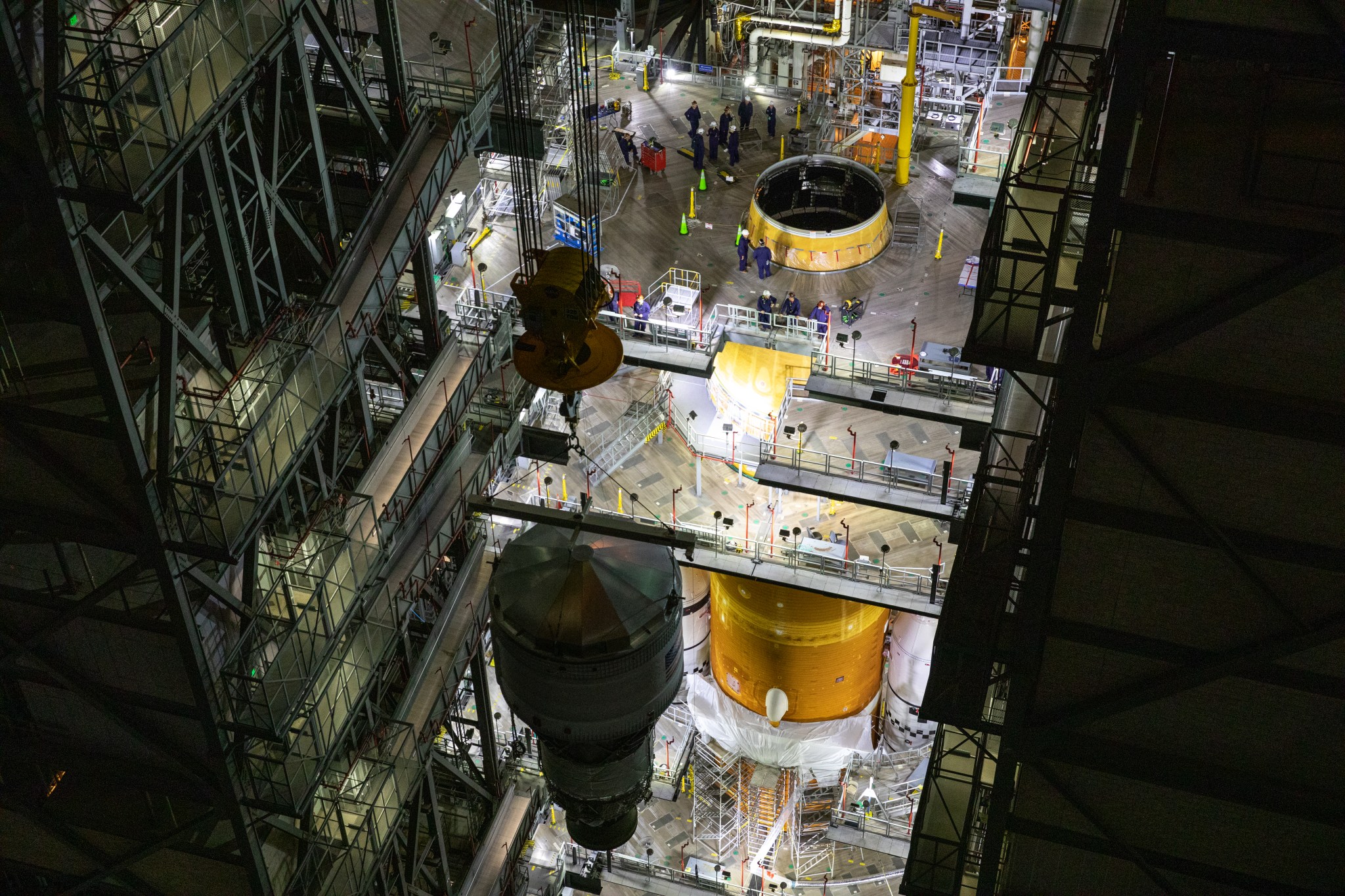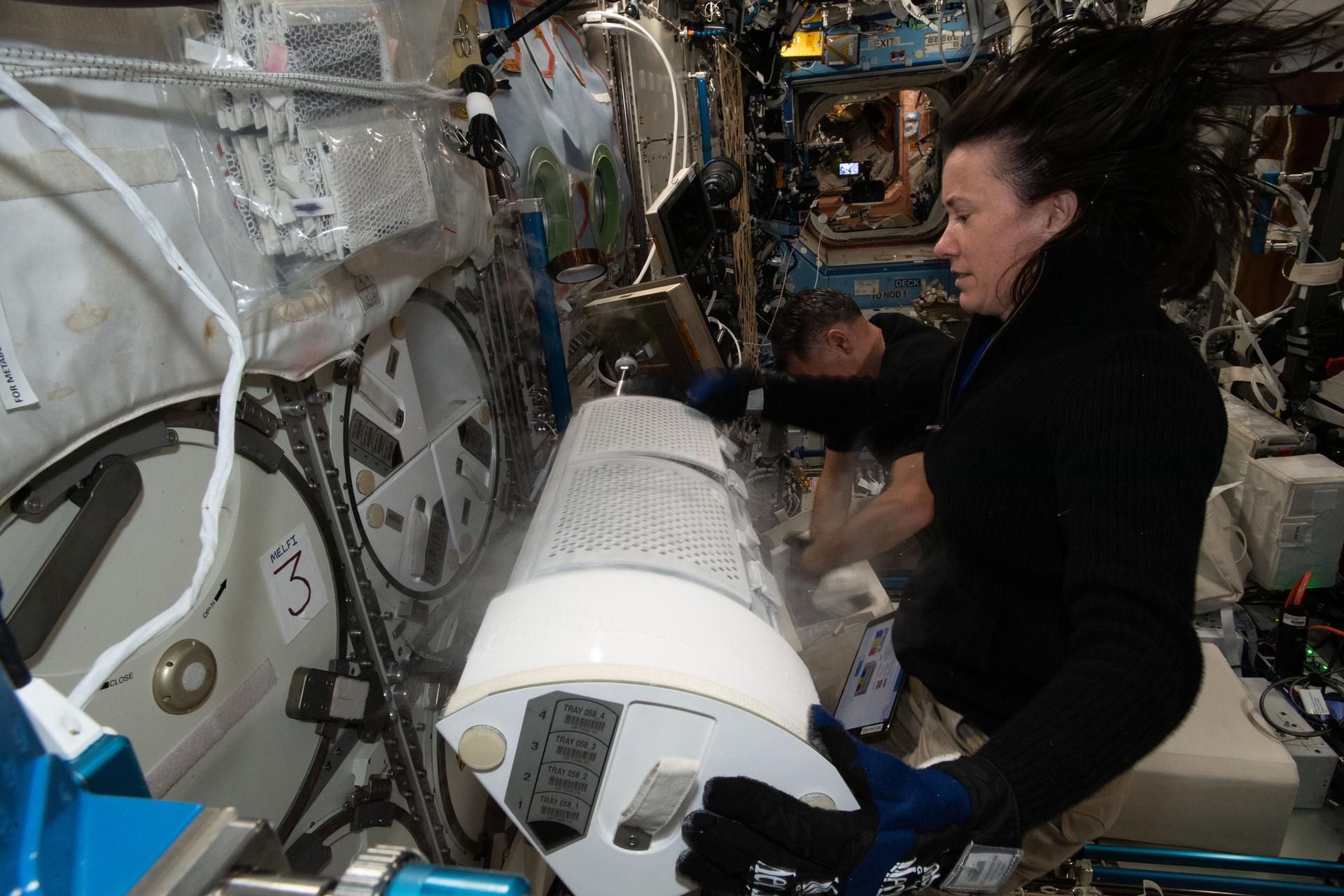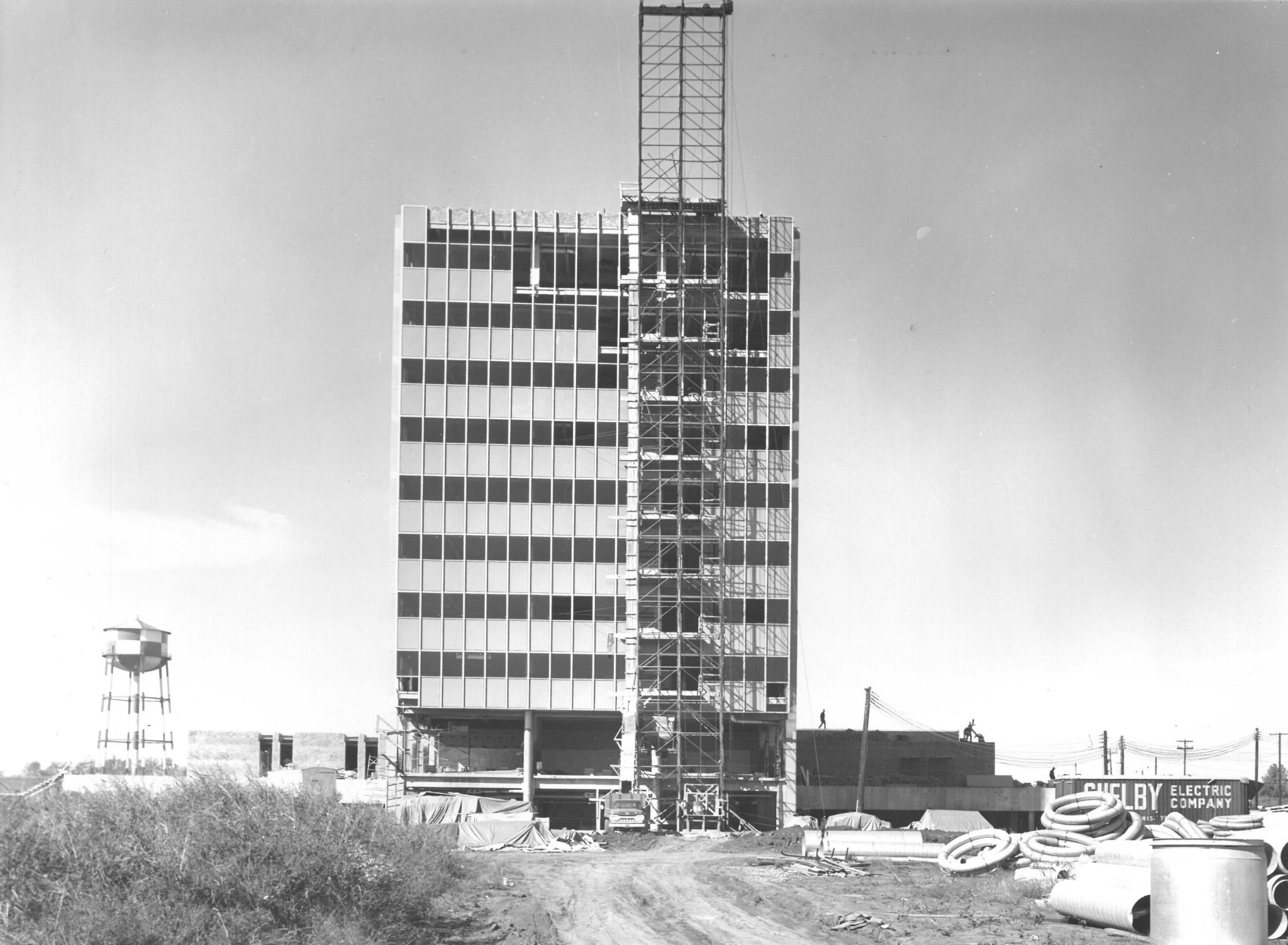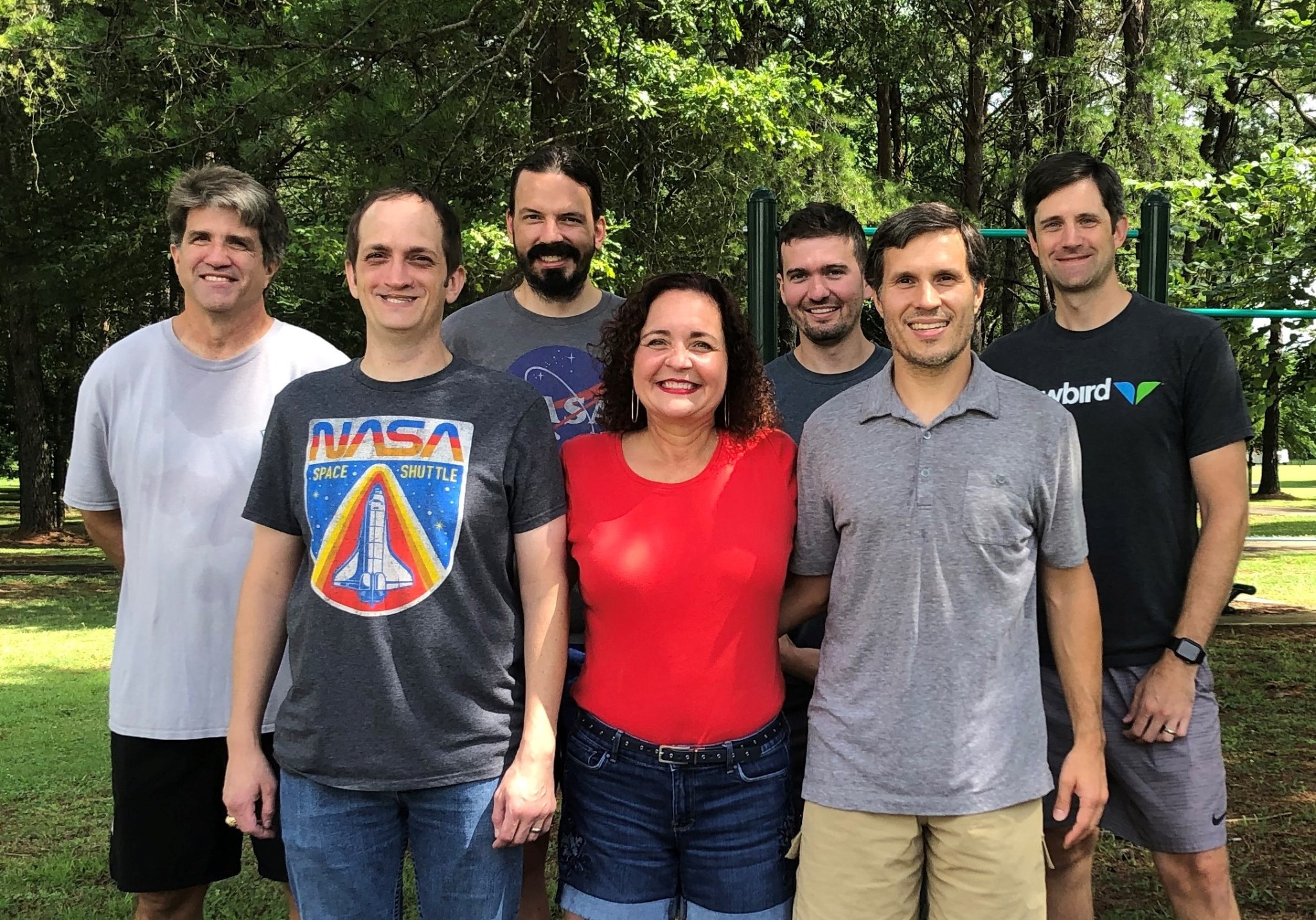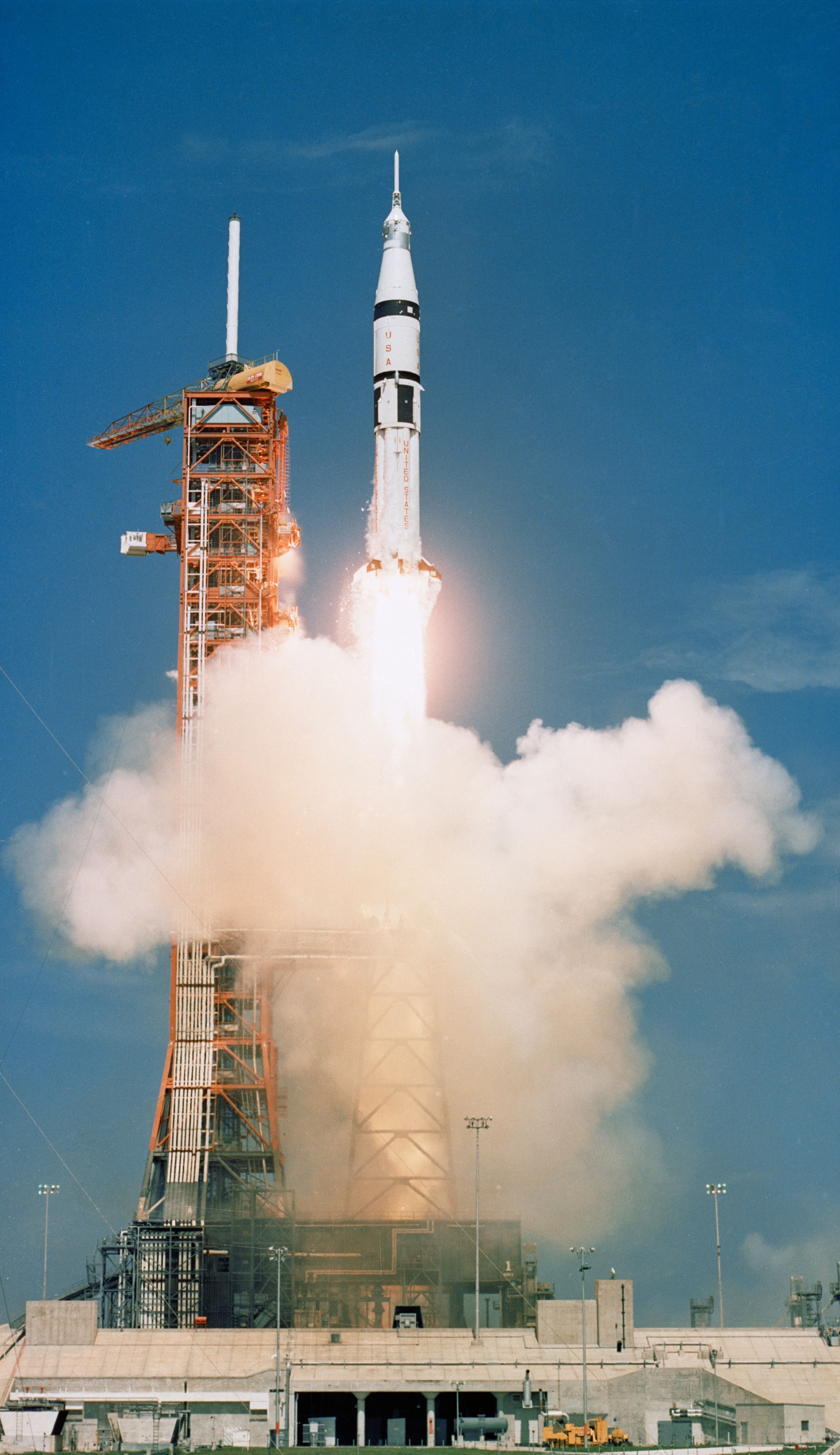Artemis I Rocket Grows Closer to Launch
The Artemis I mission reached another milestone last week inside the Vehicle Assembly Building at NASA’s Kennedy Space Center. On July 5, teams with Exploration Ground Systems and contractor Jacobs stacked the Interim Cryogenic Propulsion Stage, or ICPS, atop the Space Launch System rocket.
The ICPS’s RL 10 engine is housed inside the launch vehicle stage adapter, which will protect the engine during launch. The adapter connects the rocket’s core stage with the ICPS, which was built by Boeing and United Launch Alliance.
The ICPS will fire its RL 10 engine to send the Orion spacecraft toward the Moon. Its European-built service module will provide the power to take the spacecraft on a journey tens of thousands of miles beyond the Moon.
Before attaching the Orion spacecraft to the rocket, teams will conduct a series of tests to assure all the rocket components are properly communicating with each other, the ground systems equipment, and the Launch Control Center.
The ICPS moved to the Vehicle Assembly Building on June 19, after technicians in the center’s Multi-Payload Processing Facility completed servicing the flight hardware inside.
Launching in 2021, Artemis I will be an uncrewed flight test of the Orion spacecraft and SLS rocket as an integrated system ahead of missions with astronauts. Under Artemis, NASA aims to land the first woman and first person of color on the Moon and establish a long-lasting presence on and around the Moon while preparing for human missions to Mars.
Cargo Craft Splashes Down, Returns Science Investigations From Space Station
A SpaceX Cargo Dragon resupply ship splashed down at about 10:30 p.m. CDT July 9 in the Gulf of Mexico near Tallahassee, Florida, completing a trip from the International Space Station that began July 8.
Splashing down off the coast of Florida enables quick transportation of the science aboard the capsule to the Space Station Processing Facility at NASA’s Kennedy Space Center, delivering some science back into the hands of the researchers as soon as four to nine hours after splashdown. This shorter transportation timeframe allows researchers to collect data with minimal loss of microgravity effects.
Among the scientific investigations Dragon returned were:
- Lyophilization-2 examines how gravity affects freeze-dried materials and could result in improved freeze-drying processes for pharmaceutical and other industries. Freeze-drying also has potential use for long-term storage of medications and other resources on future exploration missions.
- Molecular Muscle Experiment-2 tests a series of drugs to see whether they can improve health in space, possibly leading to new therapeutic targets for examination on Earth.
- Oral Biofilms in Space studies how gravity affects the structure, composition, and activity of oral bacteria in the presence of common oral care agents. Findings could support development of novel treatments to fight oral diseases such as cavities, gingivitis, and periodontitis.
The Payload Operations Integration Center at NASA’s Marshall Space Flight Center oversees all experiments and science communications aboard the station.
Dragon launched June 3 on a SpaceX Falcon 9 rocket from Launch Complex 39A at Kennedy. The spacecraft delivered more than 7,300 pounds of research investigations, crew supplies, and vehicle hardware to the orbiting outpost. Dragon’s external cargo “trunk” carried six new ISS Roll-Out Solar Arrays, two of which Expedition 65 crew members Shane Kimbrough of NASA and Thomas Pesquet of the European Space Agency installed during three spacewalks June 16, 20, and 25.
Eric Vanderslice Recognized as HEO HErO
Eric Vanderslice is the latest team member from NASA’s Marshall Space Flight Center to be named a HEO HErO. He provided notable material and process evaluations of the reflective foil used for radiant protection of the Space Launch System Core Stage Base Heat Shield following the Green Run hot fire. Each week, the Human Exploration and Operations Mission Directorate recognizes HEO HErOes, team members from across the agency who have made vital contributions in their support of NASA’s mission to land the first woman and first person of color on the Moon. (NASA)
MSH 15-52: Cosmic Hand Hitting a Wall
Motions of a remarkable cosmic structure have been measured for the first time, using NASA’s Chandra X-ray Observatory. The blast wave and debris from an exploded star are seen moving away from the explosion site and colliding with a wall of surrounding gas.
Astronomers estimate that light from the supernova explosion reached Earth about 1,700 years ago, or when the Mayan empire was flourishing and the Jin dynasty ruled China. However, by cosmic standards the supernova remnant formed by the explosion, called MSH 15-52, is one of the youngest in the Milky Way galaxy. The explosion also created an ultra-dense, magnetized star called a pulsar, which then blew a bubble of energetic particles, an X-ray-emitting nebula.
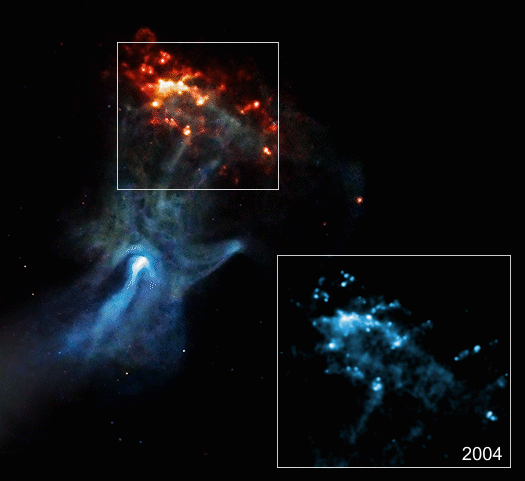
Since the explosion, the supernova remnant – made of debris from the shattered star, plus the explosion’s blast wave – and the X-ray nebula have been changing as they expand outward into space. Notably, the supernova remnant and X-ray nebula now resemble the shape of fingers and a palm.
Previously, astronomers had released a full Chandra view of the “hand.” A new study is reporting how quickly the supernova remnant associated with the hand is moving, as it strikes a cloud of gas called RCW 89. The inner edge of this cloud forms a gas wall located about 35 light-years from the center of the explosion.
To track the motion, the team used Chandra data from 2004, 2008, and then a combined image from observations taken in late 2017 and early 2018.
The motion of the explosion’s blast wave is located near one of the fingertips. This feature is moving at almost 9 million miles per hour. Some of this explosion debris is moving at even faster speeds of more than 11 million miles per hour.
While these are startling high speeds, they actually represent a slowing down of the remnant. Researchers estimate that to reach the farthest edge of RCW 89, material would have to travel on average at almost 30 million miles per hour. This estimate is based on the age of the supernova remnant and the distance between the center of the explosion and RCW 89. This difference in speed implies that the material has passed through a low-density cavity of gas and then been significantly decelerated by running into RCW 89.
The exploded star likely lost part or all of its outer layer of hydrogen gas in a wind, forming such a cavity, before exploding, as did the star that exploded to form the well-known supernova remnant Cassiopeia A (Cas A), which is much younger at an age of about 350 years. About 30% of massive stars that collapse to form supernovas are of this type. The clumps of debris seen in the 1,700-year-old supernova remnant could be older versions of those seen in Cas A at optical wavelengths in terms of their initial speeds and densities. This means that these two objects may have the same underlying source for their explosions, which is likely related to how stars with stripped hydrogen layers explode. However, astronomers do not understand the details of this yet and will continue to study this possibility.
A paper describing these results appeared in the June 1 issue of The Astrophysical Journal Letters, and a preprint is available online. The authors of the study are Kazimierz Borkowski, Stephen Reynolds, and William Miltich, all of North Carolina State University in Raleigh.
NASA’s Marshall Space Flight Center manages the Chandra program. The Smithsonian Astrophysical Observatory’s Chandra X-ray Center controls science from Cambridge Massachusetts and flight operations from Burlington, Massachusetts.
Read more from NASA’s Chandra X-ray Observatory. For more Chandra images, multimedia, and related materials, visit here.
Marshall Prepares to Demolish, Replace Key Administrative Building
By Rick Smith
For nearly 60 years, NASA personnel in Building 4200, the administrative headquarters of NASA’s Marshall Space Flight Center, spearheaded some of the nation’s most groundbreaking space exploration and discovery missions.
That historic building will be torn down in early 2022, making way for state-of-the-art “green” facilities that will make more efficient use of taxpayer dollars and house new generations of engineers, scientists, and support teams – the true core of Marshall’s legacy, and the vanguard of future space frontier expansion for untold decades to come.
“Our workers, not our buildings, are the heart of Marshall,” Marshall Director Jody Singer said. “Our top priority will always be protecting the health and safety of our team.”
Since it opened on Redstone Arsenal in 1963, Building 4200 has been home to Marshall’s executive staff, plus civil servants and contract personnel supporting the human relations, legal, communications, and public affairs organizations. It housed the offices of 14 Marshall directors, from Dr. Wernher von Braun – who led rocket development in the 1960s and 1970s – to Singer, the first woman to serve as Marshall’s director.
Since then, Marshall has overseen development of propulsion systems for the Space Shuttle Program; designed and built International Space Station hardware and life support systems and managed station science operations; delivered cutting-edge science satellites and instruments; and led NASA’s development of the Space Launch System, soon to carry Artemis-era explorers back to the Moon and pave the way for human missions to Mars.
Sixty years on, Marshall facilities engineers had a plan in place to decommission the aging building in 2030. Marshall’s facilities master plan is a blueprint for the systematic demolition of old buildings – those which can no longer be cost-effectively maintained and may pose potential health and safety issues due to their age or deteriorating condition – to make way for new, more efficient laboratories, test facilities, and offices, which cost less to build and maintain than those they will replace.
Ultimately, the plan seeks to cut infrastructure operating costs and reduce the center’s overall “footprint” of facilities and structures on Redstone by more than 25%.
“Decommissioning and replacing 4200 was always part of Marshall’s plan to be good stewards of taxpayer dollars,” said Jeff Brown, manager of Marshall’s Facilities Management Office. That plan was accelerated in early 2020 when an exterior wall panel came loose from the structure and fell eight stories to the ground. Because the center was closed, with personnel teleworking in keeping with COVID-19 safety protocols, almost no one was on-site at the time. No injuries occurred.
Determining that the falling panel was caused by deterioration of rubber mounting brackets on the exterior panel, Marshall facilities managers reassessed the building’s aging utilities, elevators, and amenities and decided to move the structure forward on the scheduled demolition list. Once the demolition contract is awarded this fall and the site cleared to proceed, the work is expected to take roughly one year.
Brown’s team oversaw the placement of safety netting around Building 4200 to minimize risk from additional falling panels prior to demolition. They also surveyed other Marshall buildings to ensure the bracket issue would not reoccur, Brown said, and shared their findings with other NASA centers and federal agencies – helping protect workers and resources among other aging federal buildings awaiting refurbishment or replacement.
At the time of its closure, more than 400 people worked in Building 4200. Marshall leadership will move to the top floor of Building 4221 on the north side of the 4200 complex – a previous entry in NASA’s plan to measurably improve infrastructure health, safety, and cost benefits. To maximize efficient workflows across Marshall’s science, engineering, propulsion, and support organizations, Brown said, hundreds more across campus were reorganized into new spaces to make room for the 4200 transplants.
Even as the plan for Building 4200 is accelerated, other demolition work continues. Building 4201, which sits adjacent to 4200, will undergo demolition this fall. Also set for decommissioning is Building 4487, home to science and avionics research for more than half a century. These structures can no longer be efficiently maintained due to their age and outdated electrical system, plumbing, and other utilities.
Building 4487 will be replaced by a new, cost-effective optics laboratory and a world-class science center housing an astrionics laboratory, devoted to the development of next-generation spacecraft electronics, subsystems, and components capable of withstanding punishing long-term missions in space.
The legacy of invention and ingenuity in Building 4200 will endure, Brown said. His team is working closely with NASA’s History Office and the Alabama State Historic Preservation Office to ensure the history of the building is preserved. Many of the high-fidelity Apollo-era, space shuttle, and Space Launch System models and artworks, including those previously displayed in the 4200 lobby, are on display in the Building 4221 lobby or stored in warehouses until new gallery space is designated.
Thousands of photos, videos, documents, drawings, blueprints, artworks, and artifacts, collected from the time of facility construction to its closure, are being archived and will be made available for public access and use. Additional site documentation by the Historical American Building Survey and Historical American Engineering Record is stored in the Library of Congress and is available online to the public.
In the end, Brown echoed Singer’s sentiment: Marshall isn’t just vintage brick, cement, and glass structures, but an evolving community of committed professionals, pursuing NASA’s mission to the benefit of all humankind.
“Part of NASA’s mission is to provide the best, most cost-effective facilities to advance the nation’s goals in space,” he said. “The right facilities make that work happen.”
Smith, a Manufacturing Technical Solutions employee, supports Marshall’s Office of Strategic Analysis & Communications.
Marshall Team Wins NASA Moves! Challenge, Michoud Honored
The Fluid Motion team from NASA’s Marshall Space Flight Center won the team award in the eighth annual NASA Moves! Challenge, a fitness competition structured so that all physical activity can be captured and converted into countable steps. Fluid Motion team members, all of whom work in the Engineering Directorate’s Fluid Dynamics Branch, are, front, from left, Brian Richardson, Lisa Griffin, and Matt Casiano; and back, from left, Jeff West, Kalen Braman, Alex Murdaugh, and Brandon Williams. Thomas Shurtz is not pictured. Fluid Motion finished first among 430 teams across the agency, after finishing in second place in 2019 and 2018. West, the team’s captain, tied for first place among the 4,070 individual competitors. Another Marshall team – Let the Wookie Win!, consisting of Joey Kirkpatrick and John Reese – placed fourth. Marshall had 189 individuals and 24 teams take part. Michoud Assembly Facility was recognized for having the largest percentage increase in participation, going from no participants in 2020 to 19 in 2021. NASA Headquarters won the center competition. (Lisa Griffin)
This Week in NASA History: Final Launch of the Saturn IB – July 15, 1975
This week in 1975, the final Saturn IB rocket launched from NASA’s Kennedy Space Center for the Apollo-Soyuz Test Project – an international partnership between the U.S. and Soviet space programs. A Soviet Soyuz rocket launch preceded the Saturn IB launch. Designed to test the compatibility of rendezvous and docking systems and the possibility of an international space rescue, the nine-day mission brought together NASA astronauts Tom Stafford, Donald “Deke” Slayton, and Vance Brand in an Apollo command and service module and Russian cosmonauts Aleksey Leonov and Valeriy Kubasov in a Soyuz capsule. During nearly two days of joint activities, the cosmonauts and astronauts carried out five joint experiments. Today, NASA’s Marshall Space Flight Center is playing a vital role in the Artemis program by developing the Space Launch System, the backbone of NASA’s exploration plans and the only rocket capable of sending humans to the Moon and Mars. The NASA History Program is responsible for generating, disseminating, and preserving NASA’s remarkable history and providing a comprehensive understanding of the institutional, cultural, social, political, economic, technological, and scientific aspects of NASA’s activities in aeronautics and space. For more pictures like this one and to connect to NASA’s history, visit the Marshall History Program’s webpage. (NASA)















